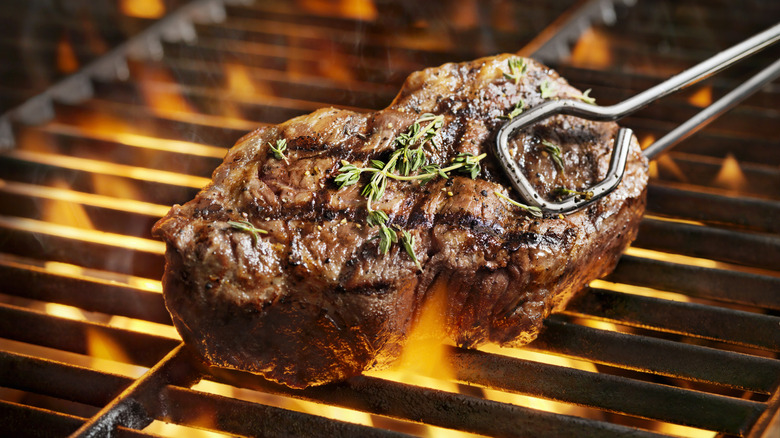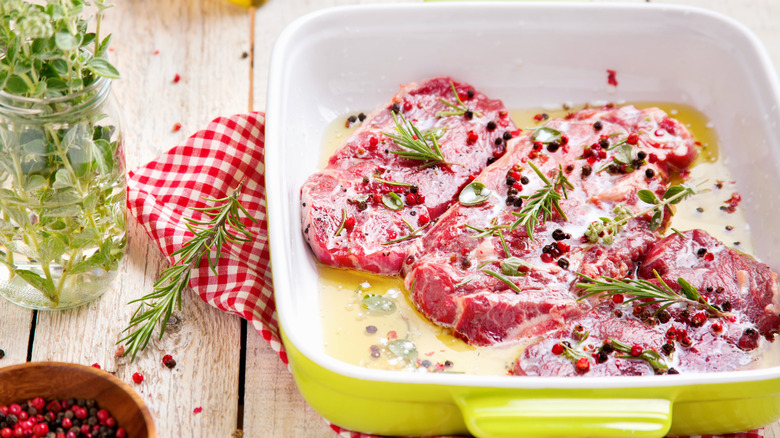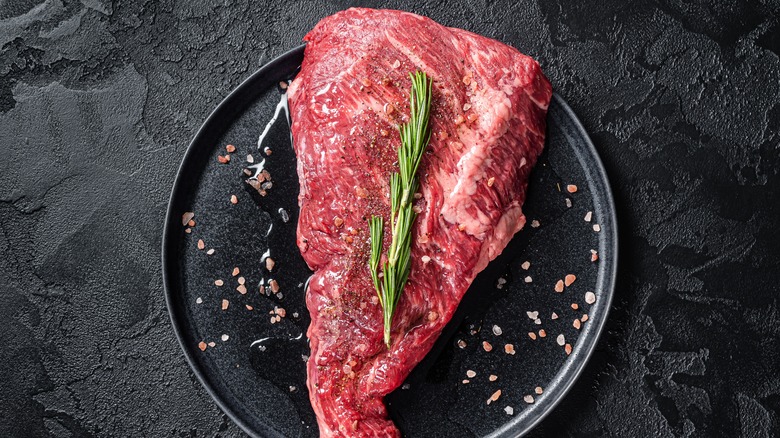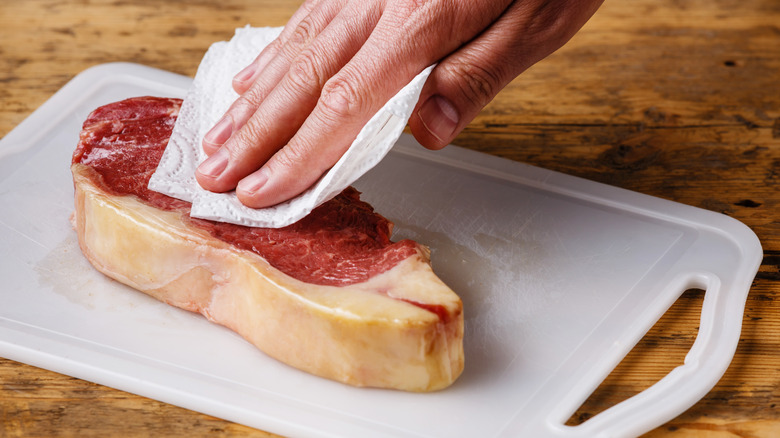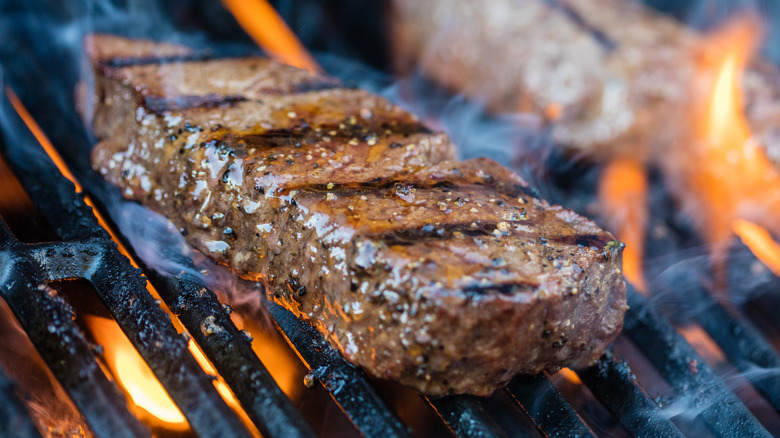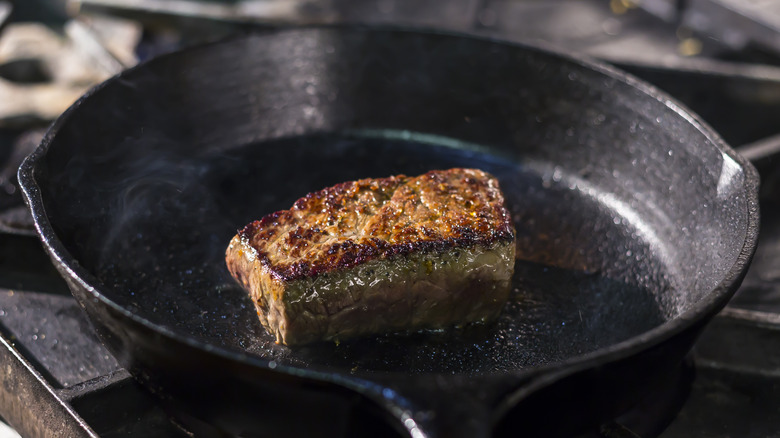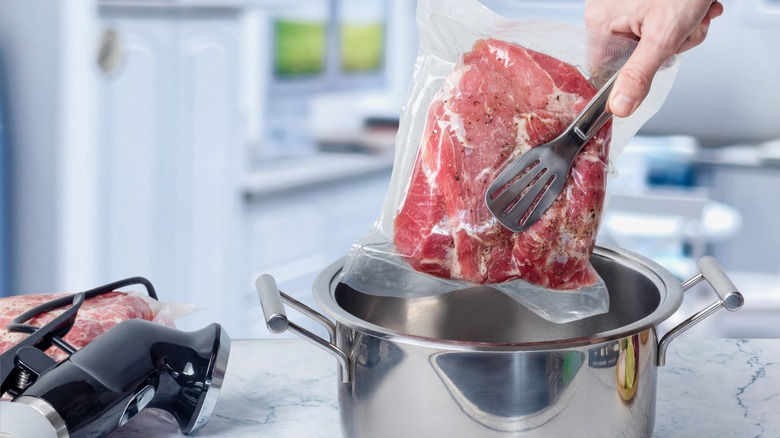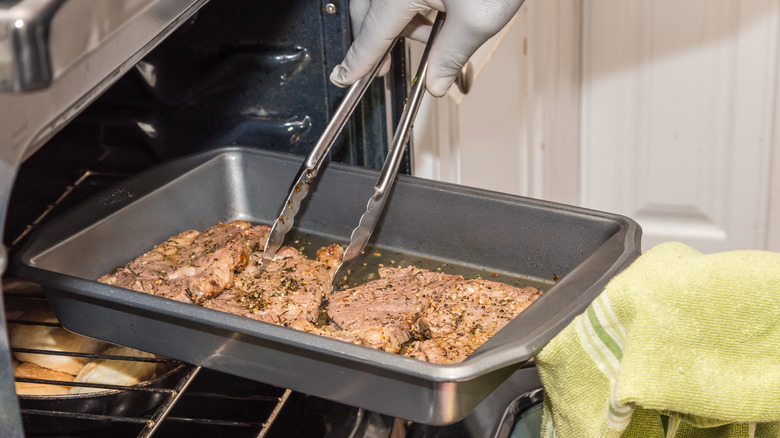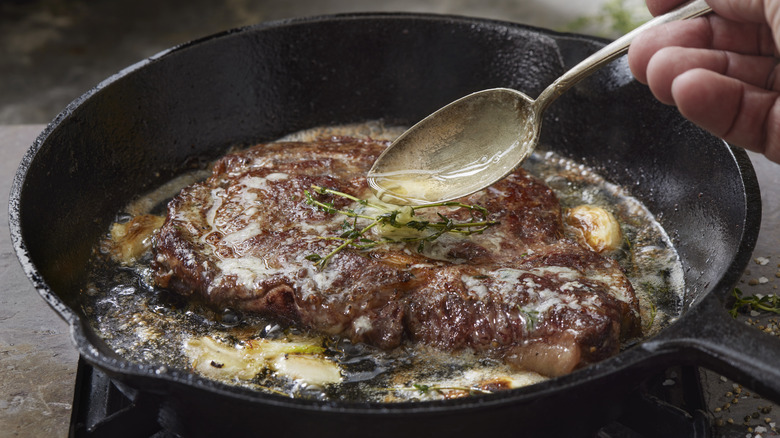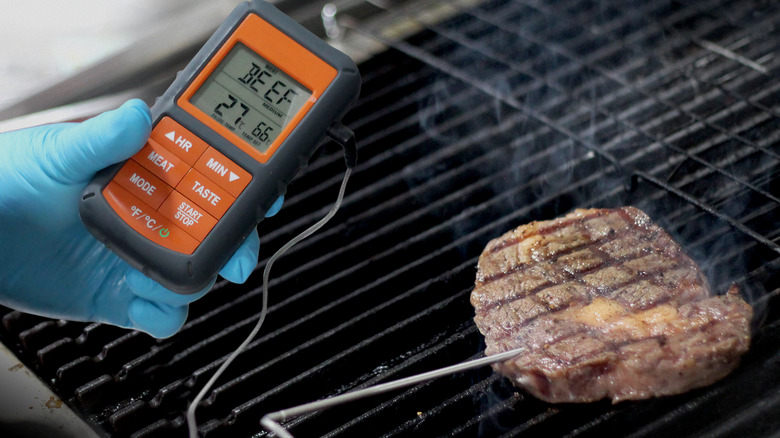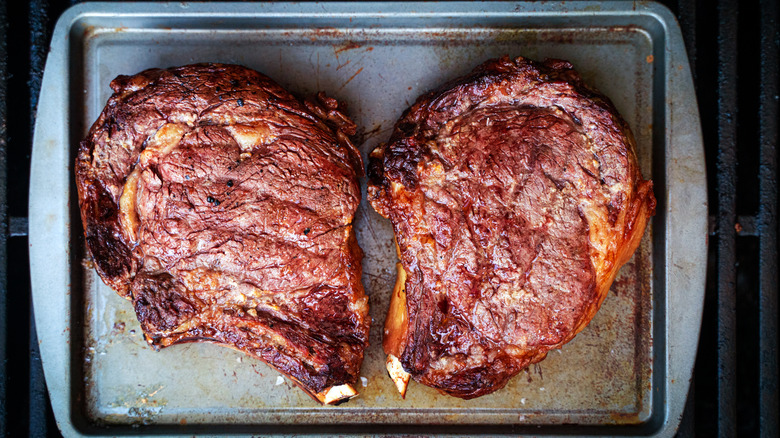10 Tips To Cook Unbelievably Juicy Sirloin Steak
In the hierarchy of steaks, sirloin doesn't get much love. It lacks the robust, unctuous fattiness of a ribeye, the tenderness of filet, or the versatility of New York strip. But that doesn't mean it's unworthy. It's a lean, full-flavored steak with a bit more chew than the others, which, again, isn't a bad thing.
Sirloin is one of three sub-primal cuts derived from the loin primal. The more glamorous of the three are the neighboring strip loin and tenderloin. These two cuts are responsible for fillets, porterhouses, and t-bones. The strip and tenderloin sit behind the rib cage and are far from the "hooves and horns," meaning they create the most tender meat. The sirloin bridges the space between those and the rump and gets a bit more of a workout than the other two, meaning less fat and denser muscle fibers — but that doesn't have to translate to tougher or drier meat.
The sirloin gets split into two parts: the top and bottom sirloin. Cuts intended for slow roasting, such as the tri-tip, and cuts intended for very fast cooking, like the bavette, are often fabricated from the bottom sirloin. The top sirloin is the source for steaks like the culotte, also known as picanah, sirloin fillet, or the generic "sirloin steak," which contains a little of both steaks. Not that they aren't already, but applying a little care and technique helps steaks from the sirloin be every bit as luxurious as any of the "fancy" cuts.
Marinate your sirloin steak
While sirloin steaks are flavorful and tender enough on their own, you can build up the flavor, texture, and juiciness by giving them a marinade treatment. You can do this by pouring a bottle of store-bought salad dressing over the steaks and letting them sit for a while, or you can level it up by building your own marinade. There are tips to tenderize this cut of meat, though.
Balance your ingredients using a two-to-one ratio of oil to acidic ingredients. Balancing acidity helps keep the sourness in check. It also regulates the amount that will work into your steak's muscle fibers, which wreaks havoc on your steak when allowed to run wild. Always balance the marinade's acidity with salt, which will also stimulate osmosis, drawing the salt and marinade into the steak.
Even when controlling the acid in your marinade, letting your steak over-marinate has the same effect as too much acid: the proteins in the meat will start to unwind and result in a mushy, dry steak. One to two hours is the sweet spot for marination to do its job well. Lightly tenderizing your steak will help the marinade penetrate quickly. Poking shallow holes with a spiked meat mallet, a needle tenderizer, or a sharp meat fork will form inroads for the marinade to penetrate. You can also use the escabèche method of marinating, where you place your steak in a hot marinade while it rests, which will help it absorb quickly.
Warm it before cooking
When you cook food, it expels water. The longer you cook it, the more moisture it loses. When a steak is cold in the center, cooking to the proper temperature takes longer, resulting in a drier piece of meat; hence, you shouldn't cook steak directly from the fridge.
When you sear a cold steak, the heat works on the exterior, slowly raising the temperature of the colder interior. As the temperature rises, the steak loses water. If you sear the meat for too long, a dry, brown ring starts to form just under the seared part, expanding towards the middle, which is still trying to reach the proper temperature.
By allowing your steak to warm on the counter for an hour, you're equalizing the internal and external temperatures of the meat. In doing this, you're enabling the heat from your cooking surface to act on the meat's exterior, which sears it, and you're also lowering the resistance to the heat radiating to the center. Because the heat transfers easily, the meat experiences less water loss, and your steak is juicier. As an aside, be sure to salt your steak during this step, too.
Dry it
Salting your sirloin steak and allowing it to warm up for an hour kicks off osmosis. The salt draws water from the steak's interior cells and replaces it with salt from the surface. After about an hour, the process will have reversed, drawing the water back into the cells. There will still be some residual moisture on the surface, so patting steak dry with a paper towel is a strong move towards a good crust and juicer sirloin.
Searing is the result of browning via the Maillard reaction. The simplest explanation is that the heat caramelizes the meat proteins. The meat needs to be dry for the heat to do its most efficient work. Otherwise, the heat will expend its energy on boiling off the surface moisture, steaming the steak before browning it. Water will never be more than 212 F, so much of the heat's energy is spent below temperatures effective for searing, for which the sweet spot is between 300 to 500 F.
This lengthy explanation is a long way to say that the resulting lower temperature will be working on your steak, trying to transfer to the interior and leaving a steamed exterior. This scenario isn't beneficial since you want a quick heat exchange to minimize water loss. Drying your steak allows the direct transfer of the higher heat to the exterior of your steak, searing it rather than steaming and moving quickly to the interior, resulting in a juicier sirloin steak.
Grill it well
Sirloin is an excellent grilling steak. But a few bits of finesse make it even better. Sirloin's leanness allows it to cook quickly without many flare-ups from rendering fat hitting the coals. Its denseness works against high-heat cooking, though.
Sirloin muscles get a workout, which results in a denser collection of muscle fibers. That density slows the transfer of heat. If you were to blast it with high, direct heat for the entire time it took to cook the steak, you'd have a dry, brown ring between the exterior crust and the cooler center part of the steak. That ring results from moisture being rapidly expelled from the meat, making a dry steak.
The best way to grill a sirloin is to set up two grilling zones, one with intense heat for searing and the other cooler, to provide more subdued ambient heat. Sear the warm, dried sirloin steak over the high heat zone for two or three minutes per side to build a good crust. Then, move it to the cooler side of the grill to let it finish cooking. If you have a small grill or some other reason that makes dual-zone cooking difficult, you can move the steak into a pre-heated 300 F oven for the lower-temperature cooking stage.
Sear it
Sirloin steaks are great for searing, too. Building a crust in a pan and then finishing it in the oven yields the best results. Here are a few tips for perfect searing: Use a thick-bottomed skillet, preferably cast iron or fully-clad stainless steel. The thick bottom helps transfer the heat more evenly than a thin aluminum, stainless, or non-stick pan, which minimizes hot and cool spots. That thickness also helps store heat, which allows the pan to recover faster after you drop a cool steak onto it, which lowers the pan's surface temperature.
Use oil judiciously for a better sear. Given the leanness of the sirloin cuts, you'll need a small amount of oil to prevent them from sticking. But too much oil can work against you. The oil can form a barrier between the pan's direct heat and the steak, which leaves you frying or (worse) boiling the steak in oil.
Keep the steak moving. Even the best-made pans have non-uniform surfaces with minute temperature variations. On top of that, wherever the steak is will be the coolest part of the pan. By moving the steak frequently, you're hitting a new hot spot for a better sear.
Sous vide it
Sirloin steaks are perfect candidates for sous vide cooking. Unlike more marbled cuts, like ribeye, which has intramuscular fat that might not render fully during water bath cooking, the leanness of sirloin is a strength. Also, its longer muscle fibers have an opportunity to tenderize during the slow cooking of sous vide.
One of the great things about cooking in a vacuum-sealed bag is that you can infuse the meat with flavors and moisture more intensely because of the bag's internal pressure. With that in mind, you can add herbs, like rosemary, thyme, or parsley, to the bag, and their flavor will permeate the steak. You can also add other flavoring ingredients, like garlic or onion, and extra richness and moisture via oils or butter that are absorbed during the cooking.
It's recommended to cook a picanah steak for two to four hours at 130 F for a medium-rare finished temperature. After finishing the sous vide cooking, remove the steak from the bag, pat it dry, and then quickly sear it over medium-high heat in a thick-bottomed pan for two minutes per side before letting it rest for 10 minutes.
Whether you're cooking sous vide, reverse searing, or "regular" searing your sirloin steak, you can use the charred bits on the bottom of the pan to make a quick pan sauce. Deglaze with wine or stock, reduce the liquid, and finish the sauce with butter or Dijon.
Reverse sear it
Reverse searing is antithetical to pan searing and finishing your sirloin steak at a low temperature. Using the reverse searing method, you're taking advantage of the properties that make other cuts of sirloin great roasting meats and minimizing water loss, which translates to a juicy steak.
Reverse searing involves slow-roasting your steak between 225 to 250 F to an internal level that's 10 to 15 degrees below your target temperature. Season, warm, and pat your steak dry, as you would for most other cooking methods. Preheat your oven and place your steak on a baking sheet, or even better, a cooling rack placed on a baking sheet, allowing the heated oven air to circulate around all parts of your steak. Cooking your steak this way can take an hour or longer, so keep in mind that this is not a quick process. If you're of the mind to, you can forgo the oven and use your grill or smoker set to the same temperature range to develop extra flavor during the slow-roasting process.
Always test your steak's temperature with a thermometer. Instant-read models are fine, and grill thermometers are even better. Remove the steak from the oven once you've reached the target temperature of 115 F. Heat a heavy-bottomed cast iron or fully-clad stainless steel pan over medium-high heat, and sear the sirloin steak long enough to develop a crust.
Be sure to baste it
Basting a steak, especially a leaner one like sirloin, adds flavor and moisture after searing. Add a knob of unsalted butter, not too much, about a tablespoon, to the pan after searing it. You can also add a garlic clove, chopped shallots, and herb sprigs, like rosemary or thyme. Using a large spoon, simply scoop the melted butter and drizzle it over the steak, repeating the action for a minute or two.
One thing these additional ingredients all have in common is that they are best when activated with heat and fat. The heat is a given, and the fat element comes from the butter. You're infusing butter with these activated flavors, adding them to the steak along with keeping the meat moist with butter.
Basting with brown butter adds even more flavor if you want to take it up a little bit. The rich, nutty flavor of the brown butter adds a deeper flavor to the steak. Just heat some unsalted butter in a pan over low heat and wait for the butter to melt, then start browning, which you'll see first from the milk solids at the bottom of the pan. Take the brown butter off the heat and use that in place of the whole butter in the searing pan. Also, basting isn't reserved solely for pan-cooked sirloin steaks. Topping grilled steaks with herb-rich compound butter as they rest works well, too.
Watch the temperature
You can take all the care in the world to sear, slow cook, and baste your sirloin steak, but if you overcook it, all that work is wasted. As steaks cook, they release moisture; the more moisture you lose, the drier the steak. Sirloin steaks are particularly unforgiving when cooked beyond medium. That's because sirloin lacks marbling and exterior fat, which makes it prone to drying. Add the density of the muscle fibers, and you've got a recipe for a dry, tough steak.
The easiest way to prevent overcooking is to know the temperature of your preferred degree of doneness and know for certain what temperature the steak is at all times. This calls for a thermometer, perhaps two. An instant-read thermometer is great for spot-checking your steak, testing periodically to ascertain the temperature. A grill thermometer, either wired or wireless, has a probe that you leave in the steak during cooking, allowing you to monitor the temperature throughout the entire cooking process. A grill thermometer is particularly useful when cooking your steak with the reverse sear method.
Let it rest
When cooking any piece of meat, resting is the final stage to ensure it's moist and juicy. This idea is especially true in leaner cuts like a sirloin steak. The cooking process propels water out of the meat as the heat penetrates it, forcing the water to expand. The water will continue to exit after you remove the steak from the heat because there's residual heat inside the steak, and the meat hasn't stopped cooking.
Placing the steak on a plate away from the heat, you can expect an additional five to 10 degrees of cooking over 10 minutes of resting. As the steak cools, it will start to reabsorb some of the juices it expelled while sitting there, equalizing back into the meat. Covering the steak with an aluminum foil "tent" keeps some of the heat from escaping, so the tent is a good idea for ensuring that your steak doesn't get cold during the process.
Another good idea is resting your steak on a cooling rack on a baking sheet. This method allows airflow around all sides of the steak, ensuring there aren't pockets of heat trapped between the steak and whatever it sits on. It also keeps the steak from sitting in a large puddle of juices that will never reabsorb and will only soften the crust you developed while searing.
